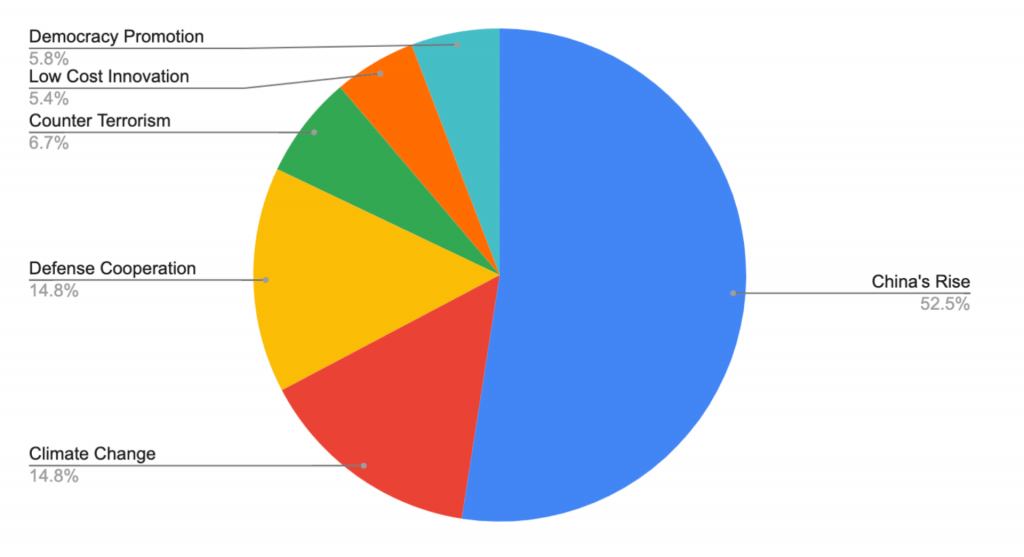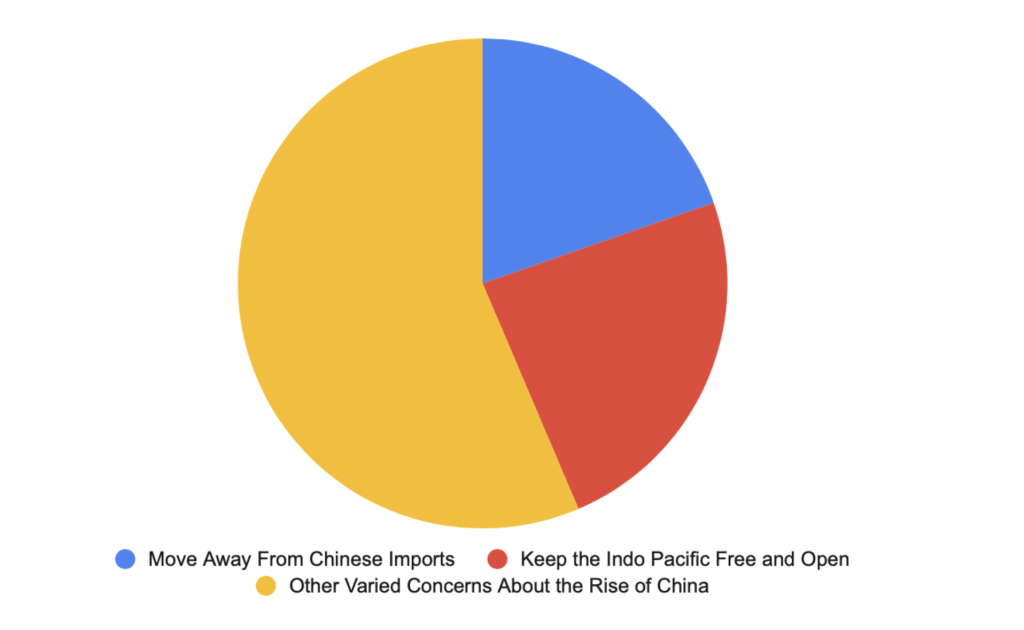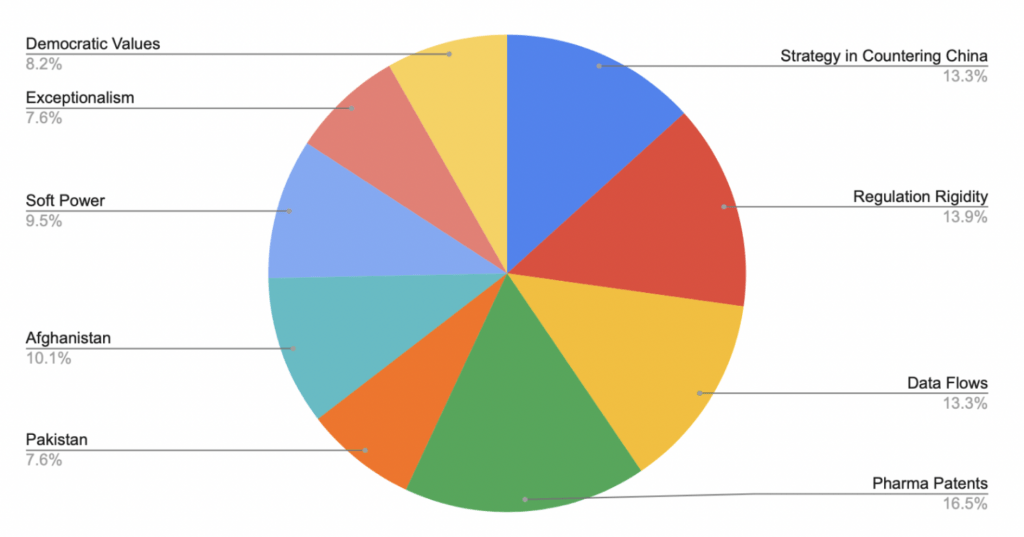February 15, 2022
When asked to give the top three convergences and top three divergences they see in U.S.-India relations, here is what a group of next generation Indian thought leaders in South India offered.
Workshop and Survey
A survey was conducted following an interactive workshop on Convergences and Divergences in U.S.-India Perspectives held by The George Washington University (Washington D.C.) and Christ University (Bangalore) in Fall 2021. Discussions between Indian students/scholars and U.S. based experts at the workshop showed that the younger demographic wants more openness, engagement and cooperation on all fronts of the U.S.- India relationship. These areas include the China question, the aftermath of the U.S. withdrawal from Afghanistan, digital tech and e-commerce.
Now we look to the results of the rich survey data to gain a more precise understanding of what Indian millennials and Gen-Z think of the relationship and how it compares to the workshop discussion. The survey reflected many of the points discussed during the student-expert exchanges, but also had some surprises.
Takeaways from the Survey
Convergences

From the graph above, we can see that the standout point of convergence is China’s Rise, with over half of the participants citing it as one of three main points. Further, participants tended to give two specific strategies for India and U.S. with respect to countering China’s rising power: ‘Move Away From Chinese Imports’ and ‘Keep the Indo-Pacific Free and Open’.

Surprisingly, Climate Change tied with Defense Cooperation as the second largest point of convergence. This finding is interesting because the topic seems to rank high for Indian Millennials and Gen Z in a bilateral relationship that is usually dominated by economic and security concerns.
Counter Terrorism, in another surprise, ranked low on convergences, whereas Pakistan and Afghanistan ranked high in divergences. This likely harks back to discussions on the precipitous exit by the U.S. from Afghanistan and how it may hamper counter terrorism cooperation.
Not surprisingly, participants seem to believe that despite the defense cooperation suffering in the past as a result of Indo-Russian cooperation, there is a significantly positive defense relationship between India and the U.S.
Low-Cost Innovation is a seemingly new convergence. Although ranking low on the scale, it could be a newer point of convergence that is slowly gaining prominence.
Divergences
Compared to convergences, the divergences identified by respondents revealed no overwhelmingly clear point of contention in the relationship.

Among many equally weighted divergences, concerns about Pharma Patents ranked the highest. To extrapolate from the workshop exchanges, it can be discerned that the ongoing pandemic and the rush for vaccines has brought the younger Indians’ attention towards an ongoing point of bilateral friction between high-cost innovation and low-cost production and supply of medication to economically marginalized populations.
Pharma Patents are closely followed by Regulation Rigidity and Data Flows. This points towards a reverse problem as compared to pharma patents—of a lack of implementation of data privacy protections by the U.S. government whereas the Indian government pushes for more. But on the regulatory issue, the U.S. regulates much more than India which wants greater flexibility to grow.
While participants clearly agreed that there was much convergence in combatting the rise of China, they identified the strategies pursued to counter China as a point of divergence. This could be because they believe that both countries are pursuing strategies that are currently proving counterproductive. It calls for discussions on how India and the U.S. can better cooperate in achieving a shared goal.
Somewhat surprisingly, students noted Exceptionalism, Democratic Values and Soft Power, as points of divergence. However, the divergence seems to boil down to one main issue—how India and the U.S. use political values to achieve their strategic goals. During the workshop discussion it was clear that there was some agreement that both countries perceive themselves to be exceptional in their own right. Instead of being an easy point of convergence, this has caused misunderstanding between the two as they assert their own exceptionalisms. This is also reflected in the convergence chart where Democracy Promotion per se ranked low. It is an interesting area for future researchers to explore.
Overall, it may be surmised that the younger Indian demographic sees more immediate and stronger areas of convergence between the U.S. and India, whereas as the divergences are rather more ambiguous and diffuse.
Note on Methodology
Findings are from an informal survey conducted in partnership between the Rising Powers Initiative, Elliott School of International Affairs, The George Washington University in Washington D.C. and CHRIST (Deemed to be University) in Bangalore during Fall 2021. A survey was sent to 350 attendees of a workshop on the topic of U.S.-India relations. Of these, 187 unique responses were received. This rate of 53% for an external survey is very high; the average rate for an external survey is 10-15%. The survey was in two parts: multiple choice and open ended. The findings reported in this Policy Commentary is based on the open-ended questions which amounted to 125 useable responses for convergences and 115 for divergences. The open-ended questions asked the respondents to list their top three convergences in the US-India relationship in order of priority and likewise for divergences. For more details, please contact gsigur@gwu.edu.
By Medha Prasanna, Research Assistant, Rising Powers Initiative and M.A. Candidate in International Affairs, Elliott School of International Affairs, The George Washington University.
This Policy Brief is a part of the ‘Shared Values and Worldviews in U.S.-India Relations’ project of the United States Government, George Washington University and Christ University. The opinions expressed here are solely of the authors and do not necessarily reflect those of the United States Government, George Washington University or Christ University.
